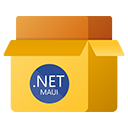a lot of useful components for .NET MAUI projects
Fluent MAUI consists of several nuget libraries. Each library contains components for a specific purpose.
For examples you can view the sample apps. this can be found at the /samples-directory
First you need to initialize FluentMaui.UI in your MauiProgram.cs:
builder.UseFluentUi(options =>
{
});
In your App.xaml, add the following lines for the styles:
xmlns:fmui="clr-namespace:FluentMAUI.UI;assembly=FluentMAUI.UI"
...
<!-- add this line for FluentMAUI.UI Styles-->
<fmui:FluentStyles />
xmlns:fmcontrols="clr-namespace:FluentMAUI.UI.Controls;assembly=FluentMAUI.UI"
...
<fmcontrols:ToggleButton />
<fmcontrols:ToggleButton Text="ToggleButton with Event"
Toggled="ToggleButton_OnChecked" />
<fmcontrols:ToggleButton Text="ToggleButton with Binding"
IsChecked="{Binding IsChecked, Mode=TwoWay}" />
you can use the EventToCommandBehavior from .NET MAUI Community Toolkit
<fmcontrols:ToggleButton.Behaviors>
<toolkit:EventToCommandBehavior EventName="Toggled"
Command="{Binding ToggleCommand}"
EventArgsConverter="{StaticResource ToggledEventArgsConverter}" />
</fmcontrols:ToggleButton.Behaviors>
notice: you can find an example for the EventArgs-Converter (ToggledEventArgsConverter) in the samples-app.
- BackgroundColor: Color
- TextColor: Color
- CheckedBackgroundColor: Color
- CheckedTextColor: Color
The WidgetView is based on the .NET MAUI Border control. You can use it to add any controls as child elements.
xmlns:fmcontrols="clr-namespace:FluentMAUI.UI.Controls;assembly=FluentMAUI.UI"
...
<fmcontrols:WidgetView />
- BackgroundStyleType: BackgroundStyleTypes (Flat, Gradient) - If the Gradient property is used and the BackgroundColor property has been set, then a gradient is automatically generated as the background. The gradient is based on BackgroundColor and becomes darker towards the bottom (15% by default). Alternatively, the background can be set directly with a brush.
An easy way to load appsettings into your .NET MAUI app.
Also, besides the primary appsettings.json, there is an option to load appsettings per platform and environment (e.g. * appsettings.android.json*, appsettings.Debug.json or appsettings.ios.Release.json, etc.).
The filename pattern is as follows: appsettings.{platform}.{environment}.json (platform and environment are both optional)
platforms:
- maccatalyst
- ios
- android
- winui
environments:
- Debug
- Release
builder.UseFluentConfiguration(options =>
{
// LoadAppsettingsFrom-Assembly is optional for ios, macos, winui BUT REQUIRED on android
options.LoadAppsettingsFrom = Assembly.GetExecutingAssembly();
});
- LoadAppsettingsFrom: Define the assembly where the appsettings are located as resource files (EmbeddedResource).
